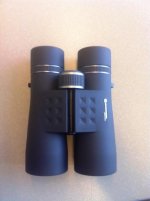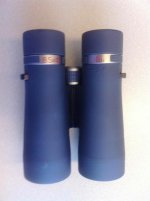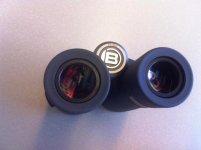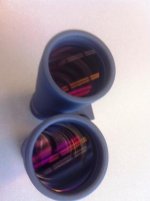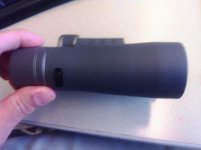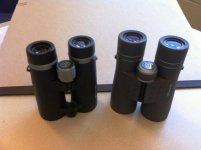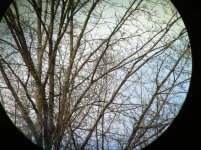FrankD
Well-known member
After posting the review of the Bresser Everest model I was contacted by Brad from Optics Camp as to whether or not I would have any interest in reviewing Bresser’s top of the line roof prism model, the Montana. Interest on this model as expressed by various members of this forum lead me to agree to the opportunity despite the fact that there isn’t any way I can currently afford to purchase it. Brad was kind enough to ship the Montana out the same day and I received it a little over a week ago. Published specs for this model are listed below.
The Bresser Montana 8.5x45
Listed specs:
- 26.3 ounce weight
- 6.5 degree (342 feet at 1000 yards) field of view
- 17 mm of eye relief
- Fully-multicoated
- Phase corrected
- Dielectric prism coating
- ED Glass – Hoya material
- 6.5 foot close focus (my eyes)
As you can see from the listed specs above the binocular does not have any particular striking feature on paper other than the use of Hoya glass in the design. The Montana is Bresser’s premium roof prism binocular and typically retails for around $900. That puts it in the same price range as the Zeiss Conquest HD and the Meopta Meostar HD. Bresser is a lesser known name in the optics arena so its appeal really boils down to its performance.
Questions are bound to arise as to the country of manufacturer. My answer is simply that I do not know. Like the Everest there aren’t any markings on either the binocular or any other of the accessories. The similarities of the Everest with other models on the market plus its low price point have led most folks to assume they are Chinese. A fair assumption based on the information on hand.
On the other hand we have the Montana which does bear quite a bit of resemblance to the Minox HG and HG APO line of binoculars. Those are German made models. The price point of the Montana is also significantly higher than the Everest so either this is the most expensive Chinese-made, consumer binocular on the market or it is either of German or Japanese origin. As for me personally, I do not have a preference for country of origin as long as quality control is good and the optical performance is there.
So how does the Bresser Montana perform optically? Well…..
Optical Performance:
Just looking at the specs on paper I wasn’t sure what to expect when looking through this binocular. It is an 8.5x model so I wasn’t sure how that was going to influence my perception. On top of that the true field of view specs are notably narrower than what I prefer and/or am accustomed to. The apparent field of view (easy method versus ISO) of approximately 55 degrees is wider than at least one or two models I have reviewed/owned recently but not necessarily at the 60 degree minimum that I tend to gravitate towards for most of my models.
So what strikes me when I first look through them?
…the apparent brightness. Again, I use the word apparent because what we perceive as brightness is usually the result of the level of contrast and color bias. Still, using the binocular under a variety of lighting conditions I cannot find any situation where I did not feel impressed by the level of light that these binoculars allow to reach your eyes. I am guessing that this is the end result of a combination of factors not limited to the quality of anti-reflective coatings and glass, dielectric prism coating and the 45 mm objective diameter.
The apparent contrast level is excellent. Blacks are truly black and whites are truly white. Objects have that certain sense of “pop” to them that almost makes them appear “3D” in representation. Furthermore, the contrast level when coupled with the apparent brightness and apparent sharpness almost gives the impression that objects “float” within the field of view. It is difficult to describe no matter how I attempt to represent it.
Apparent sharpness is excellent. In fact this is one roof prism binocular whose level of apparent sharpness equals that of any of the porros that I have owned and/or handled. I have always felt that my venerable Nikon 7x35 Widefield Action offered the highest level of apparent sharpness. It does but now I have a second model that is capable of pulling the finest detail no matter what I observe. There are some differences but I am going to leave that part out for the “nitpick” section of the review.
Color bias is neutral to almost “blue-green” in representation. In this area they remind me quite a bit of the Zeiss FLs that I owned for many years. The difference with the Bressers though, is that I don’t get any of the “washed out” effect that I occasionally did with the Zeiss. Contrast levels are very good and don’t change, for my eyes, under any evaluation condition.
Chromatic aberration control is a bit of a difficult situation to describe. The easy answer is that longitudinal color is well-controlled within the sweet spot. I don’t see any of this type of CA. Lateral color is displayed more notably as one moves away from center. I would estimate that it begins approximately half way out from center and becomes readily visible on the edges. The bands are wider and of less intensity on the edges as opposed to the thinner, more intense bands displayed by some models. Overall I would rate this model at “very good” but not quite excellent in CA control over the entire image.
So, I did bring up the sweet spot. How big is it? Pretty large in my opinion. In full daylight, the size of the sweet spot is really impressive. I don’t think that Bresser was going for true “edge to edge” sharpness with this model. What they did attempt to achieve was a very large sweet spot with a very gradual fall-off from the sweet spot into the area out of focus. Furthermore the area out of focus is only slightly out of focus and does not appear bothersome or distracting in regular use. In this area the performance reminds me of the Opticron Verano HD 8x32 that I recently reviewed….a very large sweet spot with only a slight loss in performance outside of the sweet spot. My estimation on sweet spot size would be 80-85%.
So, overall optical impressions are extremely pleasing. When you tie in all of the optical performance areas (contrast, brightness, sharpness, CA control and sweet spot size) you are left with an image that does not fail to impress you.
Ergonomics:
The ergonomics on this model are a bit different than what I am accustomed to. The binocular “feels” long though it isn’t any longer than the Leupold McKinley recently evaluated. I believe this to be the result of the contouring of the barrels. Because of the 45 mm objectives the objective tubes are tapered notably from the objectives to the eyepieces. My hands then tend to gravitate more towards the back end of the binocular since it is of a thinner diameter.
The texture of the rubber armor is extremely smooth and soft with only Brock’s “waffle iron” indents on the top side of the traditional hinge.
The eyepieces appear rather large and measure 25 mm of exposed glass. The eyecup diameter though seems average in use and measures 36 mm in diameter. I have no problem obtaining proper eye placement because of the ocular size and the eye relief level seems more than adequate for eyeglass wearers. The eyecups are tapered and very comfortable across the bridge of my nose.
Build Quality/Fit and Finish:
My impression of overall build quality of this binocular is very good. I am basing this on a few impressions. For one the binocular seems to have a good overall balance for its weight. It feels solid but not heavy. Second, all of the usual quality control areas that I examine are very good. No issues with the eyecup rotation, the diopter adjustment or the rubber armoring. Internally everything is dark black with no exposed areas of bright metal, glue or debris. I will save one nitpick in this area for the next section.
Nitpicks/improvements:
I have a few areas that I have concerns about. We can start with what I just referenced in the previous paragraph. The central hinge tension is too loose for my tastes. Now typically I don’t put too much weight into it beyond the initial quality control observation. It is a simple fix on most binoculars as you can loosen or tighten it via a small groove which is typically placed across the tripod mounting hole. After removing the tripod mounting-hole cover on this binocular though I found that it lacked the groove. Without being able to tighten the central hinge tension I often found myself knocking the IPD setting off repeatedly either when hand-holding the Montana next to another binocular for a quick optical comparison or just setting it down on a hard surface.
Second, eye placement is more critical than I would have expected. This is another area that was a bit of a surprise. I don’t think I have ever experienced “kidney-beaning” in the manner that many individuals reference with binoculars such as the Nikon SE 8x32 but I can induce it if I really push the oculars of some binoculars deep into my eye sockets. The Montana suffers from something like that phenomenon. The “blackouts” only appear if I position my eye slightly below center and then they only intrude in the lower/outer portion on the field of view. This is centered in approximately the 5 o’clock position in the right eyepiece and the 7 o’clock position in the left.
I wonder if this really isn’t a kidney bean effect at all and rather something unique to the prism design. Through email exchanges with one of the Bresser representatives I learned that the Montana utilizes Bk7 prisms instead of Bak-4. Could this somehow be a contributing factor? The effect is more pronounced if I intentionally open up the IPD beyond my preferred setting.
Third, though I don’t find it a deal-breaker the focusing tension is stiff. It has loosened up over the last week but not to the point where I would fail to mention it here. Some folks are going to find it objectionable but I do not. Focusing speed is fairly fast at 1.25 turns but not overly so. This may be partially why I don’t find the focusing tension as objectionable as other s might.
Lastly, though I don’t find the rubber armor coloration objectionable I would prefer something different than the flat gray chosen for this model. From an aesthetic perspective I enjoy the contrasting black with gun metal accents of the Everest as it gives the binocular a bit more character. Just my preferences though.
Comparison with the Everest
Over the last week I have compared the Montana with several different binoculars that I have on hand. I think an interesting comparison is between it and the less expensive Everest model. I have found that there are several key differences that separate these two binoculars beyond their price points. To make it simple to review I will break it down by characteristic and then add a few comments afterwards. Keep in mind that this comparison is based on my personal preferences. In some areas I could easily see how someone else might make a different decision based on their own preferences.
Apparent Sharpness (center of the field): Tie
Apparent Sharpness (off axis): Montana
Apparent Contrast: Montana (but close)
CA control: Tie
Apparent Brightness: Montana
Color Bias: Montana
Color Saturation: Montana
Ergonomics: Everest (I prefer the shorter overall length and open bridge design)
Quality/Fit and Finish: Montana (Though I haven’t run into any issues with the Everest, the Montana seems to have more attention to detail in some of the little issues….the feel of the rotation of the eyecups for example. Internal baffling also seems better on the Montana.)
After evaluating well over two hundred binoculars at this point I have come to some basic understandings. One of the most important, in my opinion, is the issue of apparent sharpness in the center of the field of view. In all but the least expensive models I find myself satisfied with this particular area. Furthermore, I find very little difference between several $200 models and binoculars costing 10x as much. Keep in mind that this is through regular handheld viewing conditions and not strict scientific testing done with boosted magnification. Even in the area of CA control I don’t note drastic differences in the center of the field not only between inexpensive , mid-priced and expensive models but also between ED and non-ED glass binoculars.
The differences I do note are in other areas of performance (apparent contrast, apparent brightness) as well as overall performance (including apparent sharpness and CA control) as one moves farther and farther away from the center of the field. To help clarify this issue, I find myself specifically differentiating between the terms “edge performance” and “sweet spot”. I have found many binoculars that offer adequate or even above average sweet spot size and yet their edge performance can be distracting. I have also found several models that may not have as large of a sweet spot but their transition to the edge is more gradual and their edge performance is not anyone near bothersome.
So that leads me to trying to differentiate between the mid to high priced models and some of their relatively inexpensive counterparts. Off axis performance or how well a given binocular can maintain the center of field performance over a large percentage of the field of view seems to be the predominant factor the separates the various classes of binoculars. In addition, as I mentioned above the level of contrast and apparent brightness also seem to be notable factors separating the different price points…at least as far as roof prism models are concerned.
At this stage you might be asking yourself why I am bringing this point up here. Well, in comparing the Everest to the Montana I often found myself questioning the optical performance differences. I tend to put the most weight in that area (versus quality control or ergonomics) when trying to justify price differences. In the center of the field I think these two binoculars are at about the same performance level with two exceptions. The Montanas have a brighter overall image and the color representation is much more neutral. Away from that center of the field of view the differences become more obvious. The sweet spot is larger on the Montana and the transition outside of the sweet spot is more gradual. Edge performance is also only a small amount less impressive than the center of the field performance with this model as well. In the case of the Everest the sweet spot is notably smaller and the off axis performance difference is much more noticeable.
The Bresser Montana 8.5x45
Listed specs:
- 26.3 ounce weight
- 6.5 degree (342 feet at 1000 yards) field of view
- 17 mm of eye relief
- Fully-multicoated
- Phase corrected
- Dielectric prism coating
- ED Glass – Hoya material
- 6.5 foot close focus (my eyes)
As you can see from the listed specs above the binocular does not have any particular striking feature on paper other than the use of Hoya glass in the design. The Montana is Bresser’s premium roof prism binocular and typically retails for around $900. That puts it in the same price range as the Zeiss Conquest HD and the Meopta Meostar HD. Bresser is a lesser known name in the optics arena so its appeal really boils down to its performance.
Questions are bound to arise as to the country of manufacturer. My answer is simply that I do not know. Like the Everest there aren’t any markings on either the binocular or any other of the accessories. The similarities of the Everest with other models on the market plus its low price point have led most folks to assume they are Chinese. A fair assumption based on the information on hand.
On the other hand we have the Montana which does bear quite a bit of resemblance to the Minox HG and HG APO line of binoculars. Those are German made models. The price point of the Montana is also significantly higher than the Everest so either this is the most expensive Chinese-made, consumer binocular on the market or it is either of German or Japanese origin. As for me personally, I do not have a preference for country of origin as long as quality control is good and the optical performance is there.
So how does the Bresser Montana perform optically? Well…..
Optical Performance:
Just looking at the specs on paper I wasn’t sure what to expect when looking through this binocular. It is an 8.5x model so I wasn’t sure how that was going to influence my perception. On top of that the true field of view specs are notably narrower than what I prefer and/or am accustomed to. The apparent field of view (easy method versus ISO) of approximately 55 degrees is wider than at least one or two models I have reviewed/owned recently but not necessarily at the 60 degree minimum that I tend to gravitate towards for most of my models.
So what strikes me when I first look through them?
…the apparent brightness. Again, I use the word apparent because what we perceive as brightness is usually the result of the level of contrast and color bias. Still, using the binocular under a variety of lighting conditions I cannot find any situation where I did not feel impressed by the level of light that these binoculars allow to reach your eyes. I am guessing that this is the end result of a combination of factors not limited to the quality of anti-reflective coatings and glass, dielectric prism coating and the 45 mm objective diameter.
The apparent contrast level is excellent. Blacks are truly black and whites are truly white. Objects have that certain sense of “pop” to them that almost makes them appear “3D” in representation. Furthermore, the contrast level when coupled with the apparent brightness and apparent sharpness almost gives the impression that objects “float” within the field of view. It is difficult to describe no matter how I attempt to represent it.
Apparent sharpness is excellent. In fact this is one roof prism binocular whose level of apparent sharpness equals that of any of the porros that I have owned and/or handled. I have always felt that my venerable Nikon 7x35 Widefield Action offered the highest level of apparent sharpness. It does but now I have a second model that is capable of pulling the finest detail no matter what I observe. There are some differences but I am going to leave that part out for the “nitpick” section of the review.
Color bias is neutral to almost “blue-green” in representation. In this area they remind me quite a bit of the Zeiss FLs that I owned for many years. The difference with the Bressers though, is that I don’t get any of the “washed out” effect that I occasionally did with the Zeiss. Contrast levels are very good and don’t change, for my eyes, under any evaluation condition.
Chromatic aberration control is a bit of a difficult situation to describe. The easy answer is that longitudinal color is well-controlled within the sweet spot. I don’t see any of this type of CA. Lateral color is displayed more notably as one moves away from center. I would estimate that it begins approximately half way out from center and becomes readily visible on the edges. The bands are wider and of less intensity on the edges as opposed to the thinner, more intense bands displayed by some models. Overall I would rate this model at “very good” but not quite excellent in CA control over the entire image.
So, I did bring up the sweet spot. How big is it? Pretty large in my opinion. In full daylight, the size of the sweet spot is really impressive. I don’t think that Bresser was going for true “edge to edge” sharpness with this model. What they did attempt to achieve was a very large sweet spot with a very gradual fall-off from the sweet spot into the area out of focus. Furthermore the area out of focus is only slightly out of focus and does not appear bothersome or distracting in regular use. In this area the performance reminds me of the Opticron Verano HD 8x32 that I recently reviewed….a very large sweet spot with only a slight loss in performance outside of the sweet spot. My estimation on sweet spot size would be 80-85%.
So, overall optical impressions are extremely pleasing. When you tie in all of the optical performance areas (contrast, brightness, sharpness, CA control and sweet spot size) you are left with an image that does not fail to impress you.
Ergonomics:
The ergonomics on this model are a bit different than what I am accustomed to. The binocular “feels” long though it isn’t any longer than the Leupold McKinley recently evaluated. I believe this to be the result of the contouring of the barrels. Because of the 45 mm objectives the objective tubes are tapered notably from the objectives to the eyepieces. My hands then tend to gravitate more towards the back end of the binocular since it is of a thinner diameter.
The texture of the rubber armor is extremely smooth and soft with only Brock’s “waffle iron” indents on the top side of the traditional hinge.
The eyepieces appear rather large and measure 25 mm of exposed glass. The eyecup diameter though seems average in use and measures 36 mm in diameter. I have no problem obtaining proper eye placement because of the ocular size and the eye relief level seems more than adequate for eyeglass wearers. The eyecups are tapered and very comfortable across the bridge of my nose.
Build Quality/Fit and Finish:
My impression of overall build quality of this binocular is very good. I am basing this on a few impressions. For one the binocular seems to have a good overall balance for its weight. It feels solid but not heavy. Second, all of the usual quality control areas that I examine are very good. No issues with the eyecup rotation, the diopter adjustment or the rubber armoring. Internally everything is dark black with no exposed areas of bright metal, glue or debris. I will save one nitpick in this area for the next section.
Nitpicks/improvements:
I have a few areas that I have concerns about. We can start with what I just referenced in the previous paragraph. The central hinge tension is too loose for my tastes. Now typically I don’t put too much weight into it beyond the initial quality control observation. It is a simple fix on most binoculars as you can loosen or tighten it via a small groove which is typically placed across the tripod mounting hole. After removing the tripod mounting-hole cover on this binocular though I found that it lacked the groove. Without being able to tighten the central hinge tension I often found myself knocking the IPD setting off repeatedly either when hand-holding the Montana next to another binocular for a quick optical comparison or just setting it down on a hard surface.
Second, eye placement is more critical than I would have expected. This is another area that was a bit of a surprise. I don’t think I have ever experienced “kidney-beaning” in the manner that many individuals reference with binoculars such as the Nikon SE 8x32 but I can induce it if I really push the oculars of some binoculars deep into my eye sockets. The Montana suffers from something like that phenomenon. The “blackouts” only appear if I position my eye slightly below center and then they only intrude in the lower/outer portion on the field of view. This is centered in approximately the 5 o’clock position in the right eyepiece and the 7 o’clock position in the left.
I wonder if this really isn’t a kidney bean effect at all and rather something unique to the prism design. Through email exchanges with one of the Bresser representatives I learned that the Montana utilizes Bk7 prisms instead of Bak-4. Could this somehow be a contributing factor? The effect is more pronounced if I intentionally open up the IPD beyond my preferred setting.
Third, though I don’t find it a deal-breaker the focusing tension is stiff. It has loosened up over the last week but not to the point where I would fail to mention it here. Some folks are going to find it objectionable but I do not. Focusing speed is fairly fast at 1.25 turns but not overly so. This may be partially why I don’t find the focusing tension as objectionable as other s might.
Lastly, though I don’t find the rubber armor coloration objectionable I would prefer something different than the flat gray chosen for this model. From an aesthetic perspective I enjoy the contrasting black with gun metal accents of the Everest as it gives the binocular a bit more character. Just my preferences though.
Comparison with the Everest
Over the last week I have compared the Montana with several different binoculars that I have on hand. I think an interesting comparison is between it and the less expensive Everest model. I have found that there are several key differences that separate these two binoculars beyond their price points. To make it simple to review I will break it down by characteristic and then add a few comments afterwards. Keep in mind that this comparison is based on my personal preferences. In some areas I could easily see how someone else might make a different decision based on their own preferences.
Apparent Sharpness (center of the field): Tie
Apparent Sharpness (off axis): Montana
Apparent Contrast: Montana (but close)
CA control: Tie
Apparent Brightness: Montana
Color Bias: Montana
Color Saturation: Montana
Ergonomics: Everest (I prefer the shorter overall length and open bridge design)
Quality/Fit and Finish: Montana (Though I haven’t run into any issues with the Everest, the Montana seems to have more attention to detail in some of the little issues….the feel of the rotation of the eyecups for example. Internal baffling also seems better on the Montana.)
After evaluating well over two hundred binoculars at this point I have come to some basic understandings. One of the most important, in my opinion, is the issue of apparent sharpness in the center of the field of view. In all but the least expensive models I find myself satisfied with this particular area. Furthermore, I find very little difference between several $200 models and binoculars costing 10x as much. Keep in mind that this is through regular handheld viewing conditions and not strict scientific testing done with boosted magnification. Even in the area of CA control I don’t note drastic differences in the center of the field not only between inexpensive , mid-priced and expensive models but also between ED and non-ED glass binoculars.
The differences I do note are in other areas of performance (apparent contrast, apparent brightness) as well as overall performance (including apparent sharpness and CA control) as one moves farther and farther away from the center of the field. To help clarify this issue, I find myself specifically differentiating between the terms “edge performance” and “sweet spot”. I have found many binoculars that offer adequate or even above average sweet spot size and yet their edge performance can be distracting. I have also found several models that may not have as large of a sweet spot but their transition to the edge is more gradual and their edge performance is not anyone near bothersome.
So that leads me to trying to differentiate between the mid to high priced models and some of their relatively inexpensive counterparts. Off axis performance or how well a given binocular can maintain the center of field performance over a large percentage of the field of view seems to be the predominant factor the separates the various classes of binoculars. In addition, as I mentioned above the level of contrast and apparent brightness also seem to be notable factors separating the different price points…at least as far as roof prism models are concerned.
At this stage you might be asking yourself why I am bringing this point up here. Well, in comparing the Everest to the Montana I often found myself questioning the optical performance differences. I tend to put the most weight in that area (versus quality control or ergonomics) when trying to justify price differences. In the center of the field I think these two binoculars are at about the same performance level with two exceptions. The Montanas have a brighter overall image and the color representation is much more neutral. Away from that center of the field of view the differences become more obvious. The sweet spot is larger on the Montana and the transition outside of the sweet spot is more gradual. Edge performance is also only a small amount less impressive than the center of the field performance with this model as well. In the case of the Everest the sweet spot is notably smaller and the off axis performance difference is much more noticeable.
Attachments
Last edited:




